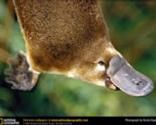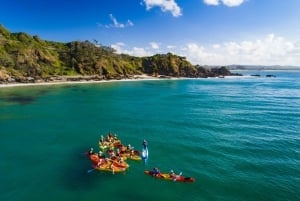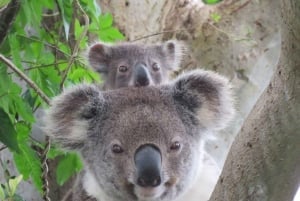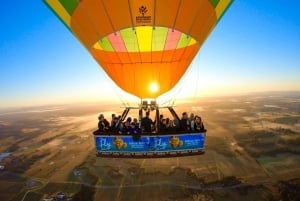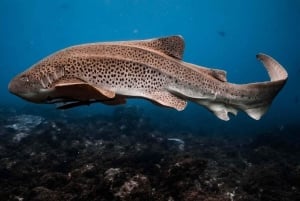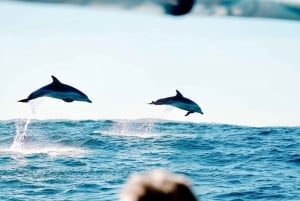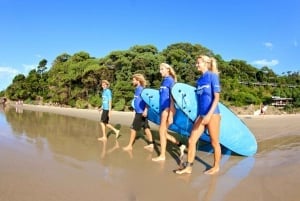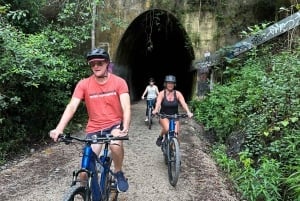Inhabitants of the Coast
Around Byron Bay and up and down the NSW North Coast you'll come across some interesting creatures and unique plants. Some are iconic aussies (everyone knows the koala, don't they?) and others are lesser known but just as special. These colourful local characters help to make our area so fascinating and fun to visit. We've listed some of the local inhabitants below, along with tips on where to go to find them and what to look out for.
Koalas
Unique to Australia, these cute looking critters are marsupials (and not bears, as some people tend to think). Koalas spend most of their time in gum trees, feeding on eucalyptus leaves and they rest for about 20 hours a day, with most of their time spent sleeping. Their awake and feeding time is usually at night. They do have very strong claws and are good at climbing up and hopping across trees. When born, baby koalas are as small as a jellybean, they have no ears and they cannot see. They live their first six months inside their mother’s pouch, sucking on milk. When they are a little bit older they stay attached to the mother, often riding on her back.
Port Stephens has one of the densest wild koala populations so you have a decent chance of seeing one here. The waterfront reserves of the Tilligerry Peninsular at Lemon Tree Passage offer good koala viewing. One of the best times to try and spot them is just before sunset. It's still light so you can see them, but they are beginning to wake.
Port Macquarie is another koala territory and home to the Koala Hospital, as well as the reknowned Billabong koala breeding facility.
If you come across an injured or dead koala, please report it to the Koala Hospital at Port Macquarie's 24 hour rescue hotline by calling 02 65841522.
Kangaroos
Kangaroos (or roos as they are nick-named) are native to Australia and are macropods (which means ‘large foot’). They are nocturnal marsupials and hold their young (joeys) in pouches. They are fascinating creatures to watch as they hop or bounce, rather than run. They can go extremely quickly with some hopping at 30 miles per hour!
Kangaroos are able to be hunted (with an official quota so as to preserve the population) and kangaroo meat is widely available for human consumption. Kangaroo steak is often featured on BBQs and can be found in restaurants. It is also widely used as a pet food here.
One of the best places on our coast to spot kangaroos in the wild is in the Crowdy Bay National Park where they graze on the camping ground at Diamond Head. The Yuraygir National Park north of Coffs Harbour is another place where you might spot a roo. The rolling paddocks near Polkolbin in the Hunter Valley is also an area where groups of kangaroos hang out en masse.
Dolphins
Bottlenose dolphins can be frequently sighted in our waters.
Dolphins are inquisitive and friendly mammals and have long been known for their seeming lack of fear around humans. There are numerous places to spot them along the coast and you can even head out on a tour to swim or kayak with them.
Byron Bay has a resident pod of friendly dolphins who frequently ride the waves with surfers and kayakers at the Pass and Watego’s beaches. A top tip is to walk up to the Fisherman's Lookout point at the Pass (you’ll see the wooden steps just past where the dive boats head out) to watch the pod slowly cruising around or playing in the waves.
Port Stephens is regarded as the dolphin capital of Australia. With around 150 of them living in these waters year round, you are pretty much guaranteed to spot a dolphin whilst visiting. There are a variety of tour operators to take you out.
Whales
Between May and November, Humpback and Southern Right whales migrate along our coastline in their thousands, heading from their summer Antarctic feeding grounds to warmer Pacific waters for breeding. For an experience to remember there are multiple whale watching tours to choose from all along the coast. If you’re not keen to head out on a boat there are also some great land based vantage points where you have a good chance of seeing them too. When whale watching, scan the horizon and look out for tell tale signs of raised tails or spouting water (when whales release water from their blow holes). A whale breaching is a spectacular sight, where these huge creatures rise from the water and thunder back down with a splash.
Byron Bay, as Australia’s most easterly point, is a top pick for whale watching. As the whales come along the coast they tend to be right in close to land here, as the Cape Byron headland juts out into their path. Climbing to the lighthouse is well worth the effort and a great whale watching spot. Iluka Bluff and Angourie Point down the Coast are also good land viewing points. Coffs Harbour is another fantastic area for whale spotting. Pack a picnic and park up on a rug overlooking the Solitary Islands at Muttonbird Island Nature Reserve. Hat Head in the Greater Port Macquarie region and Boat Harbour near Port Stephens are also on our list for land based whale viewing with a high success rate of sightings.
Kookaburras
These birds are true characters and you can spot them all over the NSW North Coast. They are a type of Kingfisher and are cheeky and not afraid of getting up close to humans. Known for their slightly hysterical sounding laugh, you’ll often hear them cackling away as the sun rises. Get used to being woken up early if you are staying near Kookaburras! They are also said to laugh when it is about to rain… so if you hear a kookaburra on a sunny day, look out. They like to eat meat so be careful when you are having a picnic or BBQ, as they might just try and steal your food!
Sea Turtles
The NSW North Coast has some great snorkelling and diving spots where you can get up close to marine turtles. Turtles are reptiles and they rise to the surface to breathe, so you can also spot them sometimes whilst swimming or kayaking.
The Julian Rocks at Byron Bay is home to 3 different types of endangered turtles: the green turtle, the loggerhead turtle and the hawksbill turtle.
The Solitary Islands Marine Reserve near Coffs Harbour is a haven for sea turtles, as is the Cook Island Marine Reserve on the Tweed Coast.
Beautiful Cabarita Beach (25 minutes’ drive north of Byron Bay) is a popular nesting spot for turtles and a good place to see them (as they come ashore to lay their eggs in the sand). The parents leave before the eggs hatch, which can be up to 10 weeks after they are laid. When the baby turtles do hatch, they can be as tiny as 4cm. They somehow know on their own to scuttle down the beach, into the water and away they go. Turtle hatching season is in March and April. It is really important that the hatchlings are not disturbed so if you are lucky enough to spot them please look but do not touch.
Injured or sick turtles on the NSW North Coast are looked after at the Sea Turtle hospital, part of the WildlifeLink Sanctuary at Ballina, a 5 acre riverside property with saltwater and freshwater lakes. This rehabilitation facility is open to school groups and the public and is also the home of the Australian Seabird Rescue.
Wombats
Wombats are mammal marsupials native to Australia. There are three different kinds of wombat and the common wombat (vombatus ursinus) has a natural habitat along pockets of the NSW North Coast.
Sadly they are not nearly as prevalent as they used to be and most Australians have never even seen a wombat in the wild. Their population is classified as ‘vulnerable’ due to poor breeding conditions, so if you do happen to see one in the wild during your travels consider yourself very lucky.
Wombats look like little bears and like koalas, they also carry their babies in pouches until they are old enough to ride on their backs. They are solitary creatures and tend to live in deep burrows which they dig themselves, sometimes up to 30 metres long. Or they'll shelter under bushes or vegetation. They come out at night and are vegetarian, eating mostly roots and grasses. Bigger wombats can be up to a metre long and can weigh around 35kg.
Parrots
Australia has over 50 different parrot species and on the NSW North coast you’ll often see brightly coloured rainbow cockatoos, white lorikeets or pink and white galahs.
The birds tend to flock together and are quite sociable. Pretty as they are, at sunset along beaches (especially where there are pine and palm trees) the noise of the combined screeching of rainbow cockatoos can be almost deafening! You might spot any of these birds sitting on power lines in towns, flying between trees or gathering on grass. Sometimes the brave ones will land on balconies or windowsills, so you may get the opportunity for some great close up photos.
Platypuses
The platypus lives throughout the east coast of Australia and makes its home in fresh water creeks, rivers and lakes. They tend to hide in burrows along the water banks.
Curious looking creatures, they are a little bit duck like, graceful in the water and with bills that look like snouts. They have webbed feet and are covered in a brown type of fur. They are mammals, but like reptiles they lay eggs. Males have a venomous stinger on the inside of their back claws, which can actually kill small creatures and would cause decent pain to a human.
Platypuses are nocturnal creatures and are quite elusive. They are shy so are not the easiest to spot in the wild. It is possible though. On the beautiful Clarence River, inland from Byron Bay you can take a platypus canoe tour at sunrise and see them in the most tranquil of settings.
Along the Coffs Coast, 25km north of Dorrigo is the Nymboi Binderay National Park, where you'll find the Platypus Flat Picnic and Camping Area. It’s near the scenic Nymboida River’s swimming holes and wild white-water rapids and is as good a spot as any to spot the creatures it was named after.
Image © National Geographic
Waratahs
The Waratah is a pretty plant that has been the flower emblem of New South Wales since 1962 (it’s also the name of the New South Wales rugby team!). They can grow up to three metres high and come early spring they bloom a lovely crimson coloured flower. You’ll most likely see them flowering on the lower reaches of the NSW North Coast from September to November.
Image from www.waratahsoftware.com.au
Echidnas
Short beaked echidnas are found only in Australia and can live in varied habitats, including urban areas.


